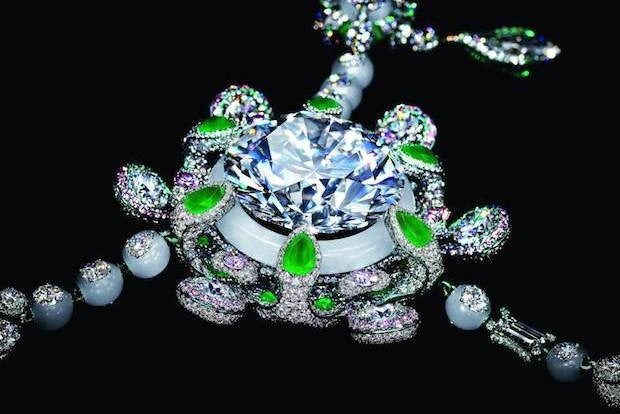
When Hong Kong jewelry brand Chow Tai Fook paid $35.3 million for one of the world’s largest and rarest diamonds, the company knew exactly which jeweler it could trust to turn it into a masterpiece: Wallace Chan.
Based in Hong Kong and regarded as one of the world’s top jewelry designers, Chan designed Chow Tai Fook’s recently unveiled “A Heritage in Bloom” necklace crafted from the Cullinan Heritage, a 507.55-carat rough diamond with the virtually flawless classification of Type IIA. The focal point of the historic piece is a 104-carat diamond cut from the Cullinan Heritage with a grade of 3-Excellent, the highest possible rating for diamonds—making it the largest of its kind ever made.
For “A Heritage in Bloom,” Chan combined a total of 24 flawless diamonds cut from the Cullinan Heritage with thousands of additional white diamonds, hundreds of pink diamonds, and over one hundred pieces of green jadeite and mutton fat white jade for a necklace that can be worn 27 different ways. Created from 47,000 hours of work, the piece’s design is laden with symbolism from Chinese culture and Buddhism and is estimated to be worth $200 million.
It’s no surprise that Chow Tai Fook chose Chan to design what is considered to be one of the most important pieces of jewelry produced in contemporary China. In 2012, Chan became the first ever Asian jeweler to be invited to present at the prestigious Biennale des Antiquaires in France. His pieces are sought after by collectors from across the world at Christie’s and Sotheby’s and can be found in museums worldwide.
With over 40 years of experience, Chan is known not just for his intricate designs, which often feature inspiration from nature, Chinese culture, and Buddhist art, but also his innovative techniques. In addition to the famous “Wallace Cut” carving technique he invented in 1987, Chan is known for his mastery of working with titanium, which was used in the creation of “A Heritage in Bloom.”
We recently caught up with Chan for an interview to discuss his creative process, the inspiration and symbolism behind “A Heritage in Bloom,” and his new illustrated monograph Dream Life Water, which showcases a curated collection of 86 of his intricate pieces and will be available in January 2016.
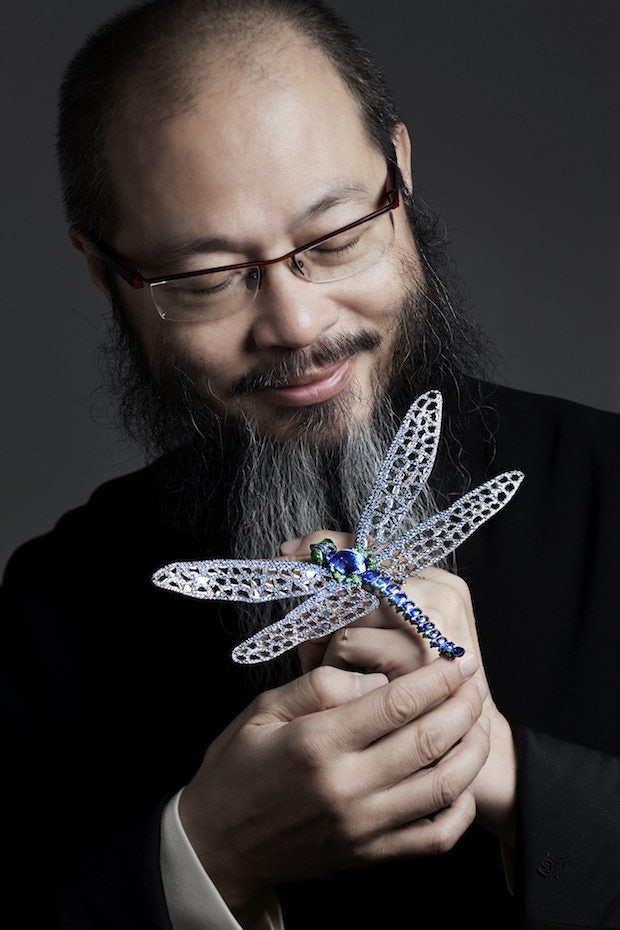
What was the inspiration for the concept of “A Heritage in Bloom”?#
When I looked at the 104 DIF diamond for the first time, I thought about its family. I saw the 507ct rough diamond as its mother, and I wanted to know its siblings. If I could, I wanted them to come home and be united again, happy as one. I am grateful that Chow Tai Fook gave me all the trust and support I needed to build the 24 diamonds a home of love and harmony.
I created this piece with a universal view on my mind; I wanted all to be harmonized. When I conversed with the 104ct diamond, I recalled a visit to a European church many years ago; I was attracted by the ceiling of the church, I felt energy going upwards, pulling me up to the dome; it was a sense of grandeur and sublime. I felt it again when I immersed in the petals of the light in the stone—the infinite reflections of the light. It bloomed in my heart like a flower of my dreams. And that was how I got my inspiration for the main stone pendant in the necklace.
To illustrate the idea of harmony, perfection, and cultural confluence further, mutton fat white jade beads with diamonds inlaid are used for the necklace. The mutton fat white jade beads take the shape of prayer beads. I thought of prayer beads as something that transcend across cultures and religions. I polished the mutton fat white jade beads to perfect roundness, emptied them out, and placed titanium parts inside them so they could be connected throughout the piece invisibly. I set a diamond inside each bead so the humility and smoothness of jade—a symbol of the East, embraces the power and sparkles of diamond—a long celebrated love of the West—with this, the confluence of cultures is achieved.
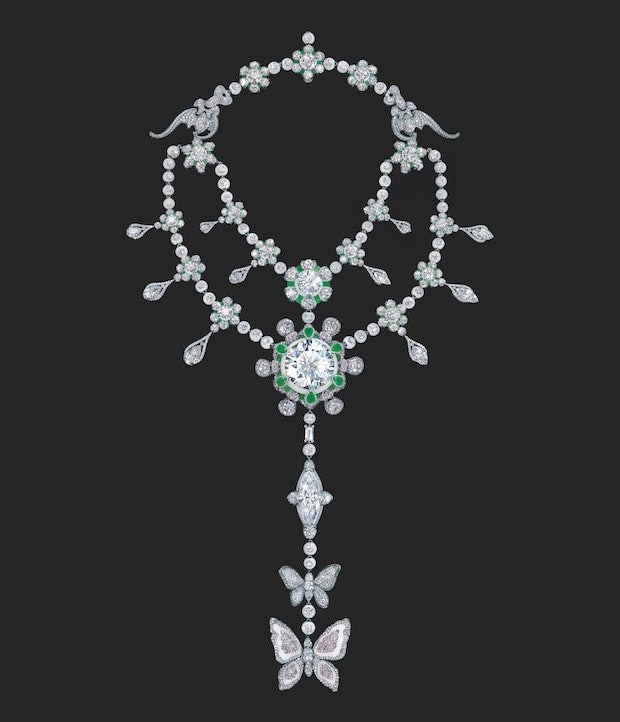
Can you discuss the symbols found in the piece’s design and materials?#
The piece must live to be a narrative, and so I placed butterflies and bats in the necklace to indicate the long history and cultural meanings it carries. Butterflies stand for everlasting love in Chinese culture, and bats symbolize happiness. An abstract feel was emphasized when creating these symbols, making reference to the ancient carving style in China, a style we call “Hongshan Culture.”
The necklace can be worn in 27 different ways—it was not the idea when I first began to create. I wanted it to be worn in five ways, as I was thinking of the Five Elements, i.e. Metal, Wood, Water, Fire, and Earth, (五行:金木水火土) that contribute to the balance and harmony of the universe. But I got carried away in the process and five became 27. In China, we have this Book of Changes (I Ching, 易經), which originated in the Zhou dynasty (周朝, 1046-256 BCE), a book of wisdom that defines three as the infinite number. Twenty-seven is the cube of three; it is, therefore, in my interpretation, a number of infinity and eternity.
Your designs have been heavily influenced by Buddhist art. What do you find compelling about it?#
I find all religions compelling. Religion, if I may put it this way, is the “ancestor” of all knowledge —from history and philosophy, to humanity, they are all derived from religions. My curiosity about life inspired my curiosity about religion, be it Buddhism, Confucianism, Taoism, or Christianity; they have all interested me.
With Buddhism, and in fact any religion, we have to come to realize that in order to understand the present, we must first understand the past. It is only in the most ancient culture that we can draw a profound lesson and thus comprehension of the modern.
In the Diamond Sutra (金剛經) there is this famous dharma, which says “we should not dwell in our own hearts (應無所住),” meaning we should not be so concerned about “where” and “what” and all the trappings of the world; enlightenment and illumination of the heart will come by naturally.
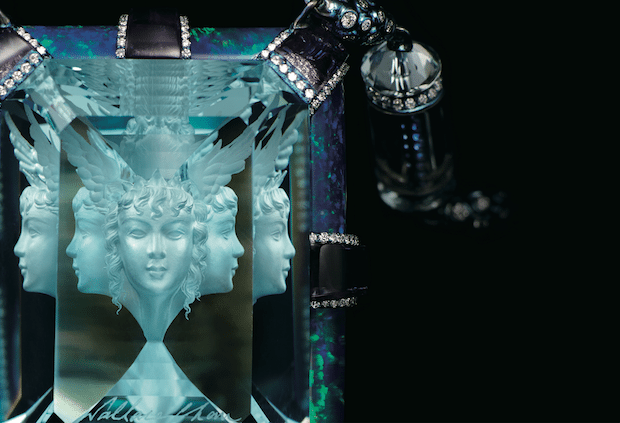
What is the focus of your upcoming book project?#
This is my very first illustrated monograph. Titled Dream Light Water, dream means imagination, light wisdom, and water attitude. It illustrates 86 pieces of my work in the past through close-up photography. It took me long years to finally find the right photography style to convey the spirit of my works. The composition of colors, forms and gemstones, as well as the details of craftsmanship are all my focuses here. I want to unveil a world within a world through the lens of the camera.
In 2012, you became the first and only jeweler from Asia to participate in the Biennale des Antiquaires in Paris. Do you feel that this will open doors for other designers from Asia?#
I feel that there are many doors, and that the doors are always open. It only takes hard work to get to the door you want, be it the Biennale or somewhere else. Throughout my 42-year long creative journey, Europe has always accepted me as who and how I am. I had my first solo exhibition in the Deutsches Edelstein Museum of Idar-Oberstein in Germany, and that was 1992. Your work defines you. Very little of it is really about which continent you come from—the cultural difference is interesting, but it is seldom the focus among professionals.
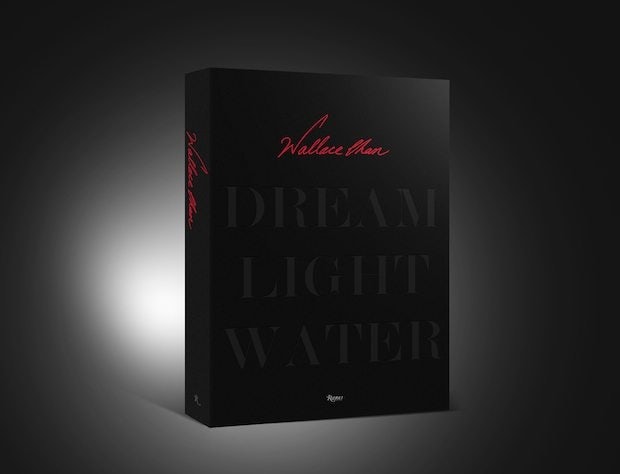
What are some of your favorite pieces that you’ve designed?#
This is the question that I am often asked, and to this day, it is still difficult for me to answer. Each creation is my own child, and I love them all so dearly. It has to be my favorite before I let it be seen by others.
The Wallace Cut has a special place in my heart. It was the first milestone of my life; it showed me that impossibilities sometimes contain possibilities bigger that those one can imagine. It took me beyond my own capabilities.
The Stupa I created for Fo Guang Shan I will always deem the most precious gift life has given me; it laid for me a solid foundation for my future innovations and creations.
“A Heritage in Bloom” is definitely one of my favorites, it is a one-of-a-kind experience, an extremely rare, once-in-a-lifetime opportunity to ever come across.
What draws you to work extensively with titanium as opposed to gold or silver?#
The mastery of titanium has expanded the freedom and possibility to create. For example, if I use a gold structure for a 20-carat diamond to create an earring, it will be too heavy for the ear, this problem inspired me to start my research on titanium.
The weight of titanium is only one-fifth of that of the same volume of gold, and it is very strong. Using titanium as the jewelry structure allows me to create jewelry with big stones, keeping the beauty of the stones without burdening the wearer. Besides, titanium can appear in different colors, and it is bio-friendly; these help remove obstacles from the process of creation and advance jewelry-making.
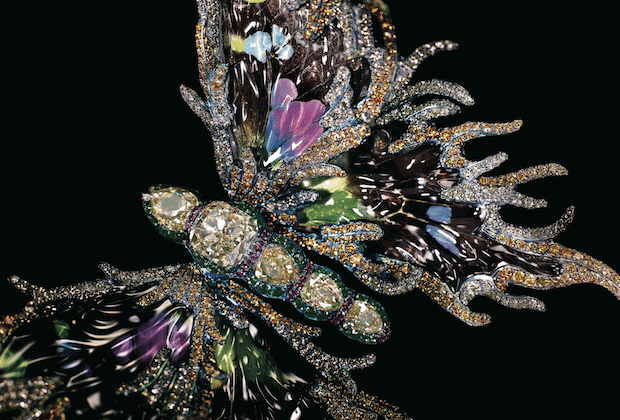
How do you balance the creative and commercial aspects of your creations?#
There is no balance. Creativity always wins. If you calculate too much, concerning too much about costs and profits you cannot create. Creativity must run free. I am simply content as long as I can continue to create.
What do you think is more important for achieving artistic success: creative vision or craftsmanship skill?#
Both are of extreme importance. I believe in a solid foundation. Craftsmanship skills provide you with the tools and methods you need to actualize your creative visions; without skills, visions are merely visions.
Your pieces are in demand among top collectors from across the world. Have you noticed that any styles or materials are more popular with Chinese collectors than with other groups?#
I prefer not to notice. I want to achieve a universal beauty that can be shared by all. If you look at “A Heritage in Bloom” again, you see that I married diamond to white jade, and I used diamond-cutting on green jadeite. Traditionally, diamond is loved by the West and jade is celebrated by the East, but to me, a contemporary being, I prefer to elaborate on the confluence of cultures that is actively taking place in our era; I would like to capture the spirit of our times and bridge differences.